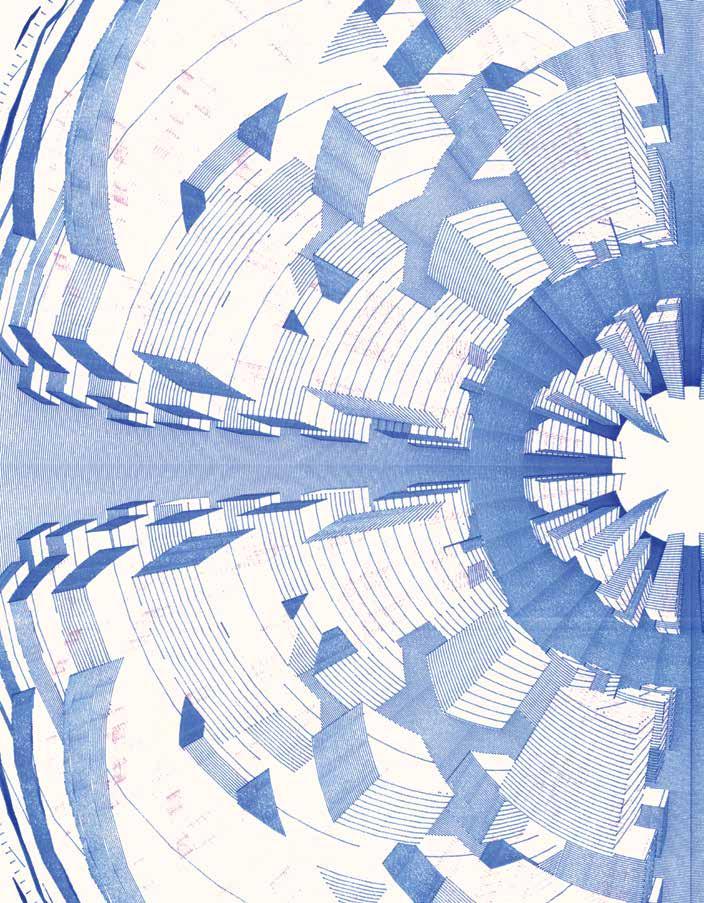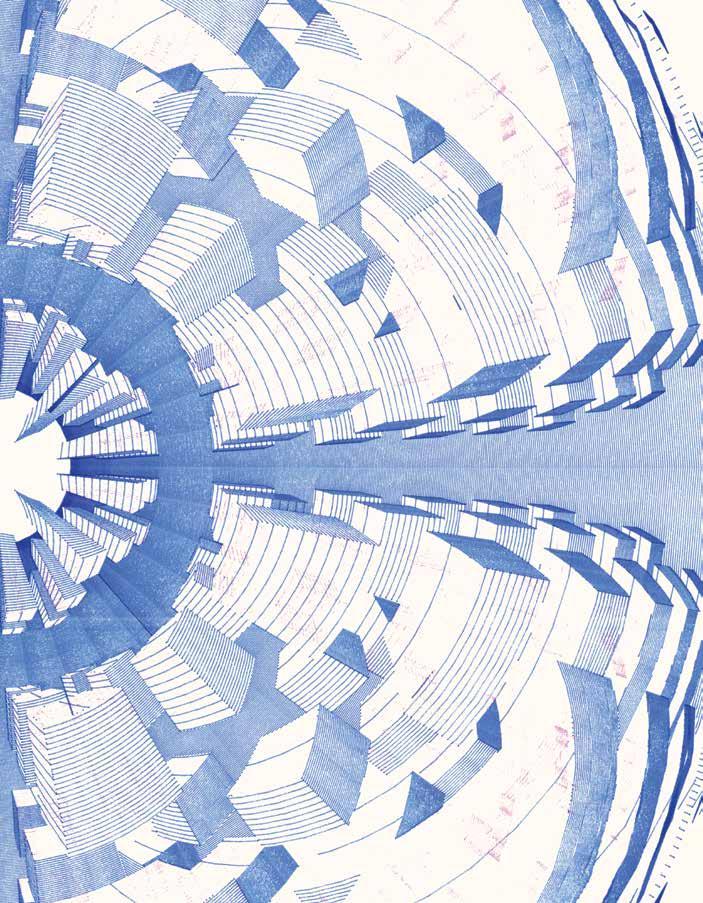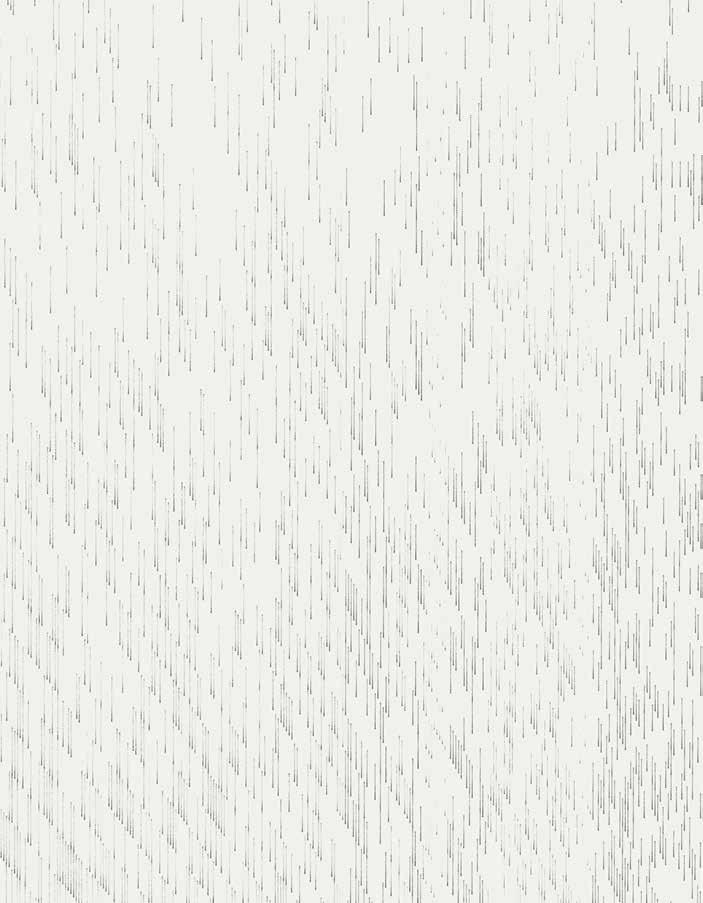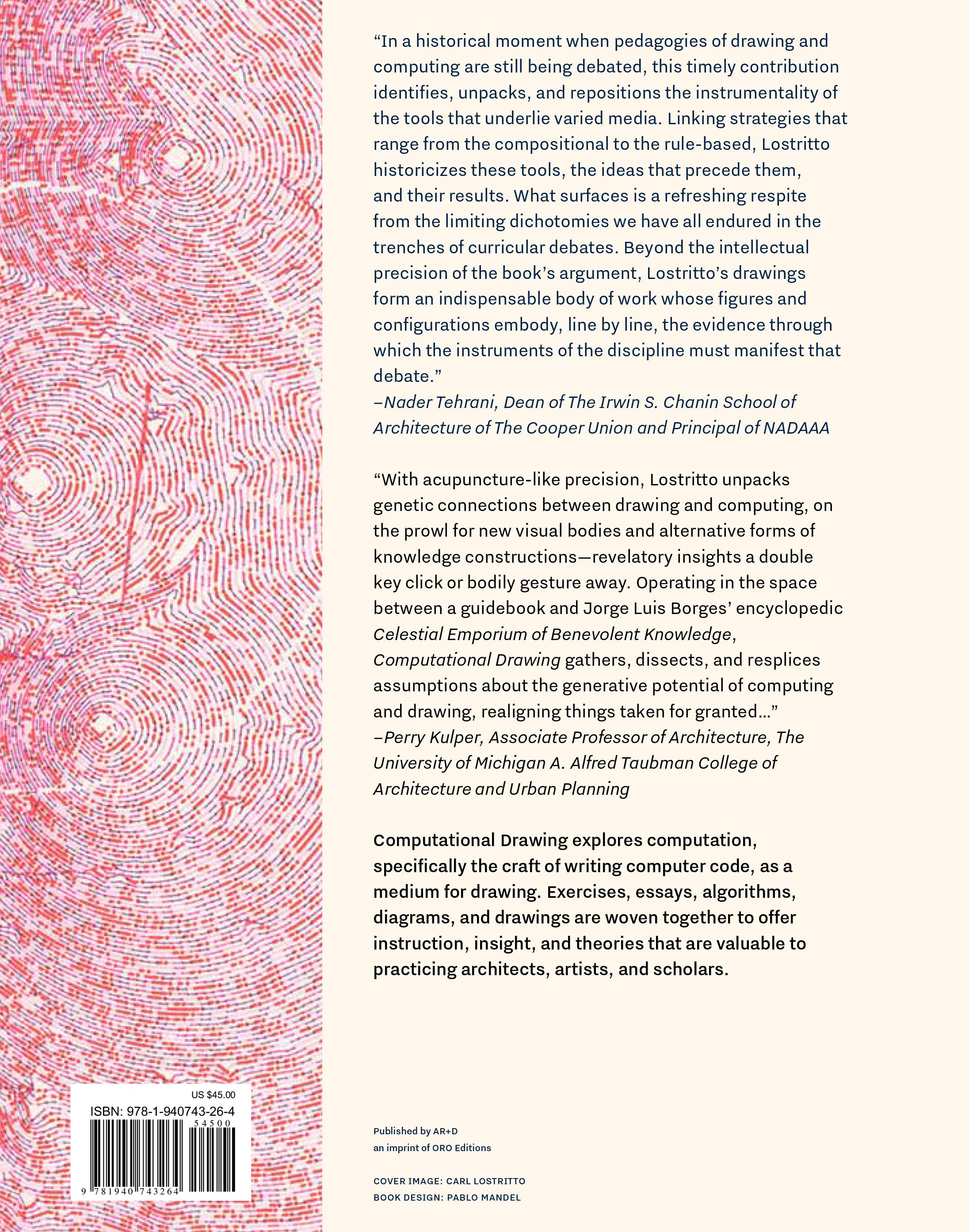
12 minute read
Exercise 1.2 / Draw from a function library
is that each mark need not be a reinvention of a new mark type. Once a kind of mark is defined, many instances of that mark can be made without invention of new mark types. As a corollary, the definition of a mark is not the same as the creation of a mark. The outer layer—the “calling”—of functions is necessary to deploy the actions that have been articulated. Both conditional statements and loops allow functions and other operations to be performed based on a logical order. If you are fluent in English, you already implicitly understand how these constructs work. Similar logic is built into our spoken and written language. A conditional statement is an if-then argument: if a condition is true, then do something. A variant on the if-then statement is the if-then-else statement, which, in more verbose terms can be articulated as, if a condition is true, then do something—otherwise—do something else. In an if-then statement, the “do something” part can be any number of things, it could be one line of code calling one of your marking functions or multiple lines of code that do anything else. A “while” construct is shorthand for while a condition is true, do something. A very basic drawing algorithm might read something like:
While the number of marks made so far is less than 100, “make a mark”.
Of course, make a mark, could be any one of your marking functions.
Exercise 1.2 Draw from a function library Using nothing more than loops and conditional statements, call your marking functions from your library by writing in plain English. Then, make another drawing using a library made by someone else.
The algorithm just given as an example is simple enough to write out as a sentence. However, when the algorithms get even slightly more layered, with loops within loops and multiple functions within each conditional, it becomes necessary to organize the code a bit more. Different programming languages do this in different ways. This book does not adhere to the conventions of any one language. Instead, algorithms are written something called “pseudocode,” which uses plain English, but is structured like a programming language. Indentations are used to group code together in segments associated with each conditional or loop. For example, the example algorithm in pseudocode is:
while the number of marks is less than 100
mark
If the marking function was called, say, “squiggle” and it took as input to numbers, an average radius and a length, we can write:
while the number of marks is less than 100 squiggle (10, 100)
How would “the number of marks” be calculated? It is important to remember that unlike humans, the computer does not “see” marks or understand what a drawing is. The programmer needs to keep track of the number of marks made in order to compare that number to a datum. So when implemented, most likely the code would look something like this:
set count to 0 while count is less than 100: squiggle (10, 100) increment count by 1
Count is a variable created by the author of the code. It starts at zero, and each time the loop iterates, it increases by one, effectively counting how many marks have been created. An example that is slightly more complex and uses if-then statements and loops together:
set count to 0 while count is less than 100: if count is even, then squiggle (10, 100) else squiggle (5, 100) increment count by 1
To conclude this chapter, consider some custom computational marks:
A squiggle is created in terms of radius, length, and the following actions currentLength starts at 0 currentAngle starts at 0
points starts as an empty list x starts as radius y starts at 0 while currentLength is less than or equal to length: newX is set to radius × cos(currentAngle) newY is set to radius × sin(currentAngle) add the (newX, newY) to points list currentLength is set to be the length of a line through points list currentAngle is modified by a random value between 1 and 5 radius is modified by a random value between -3 and 3 create a smooth line through the points list
A variablyThickLine is created in terms of startPoint, endPoint and a list of thinMoments vector is established between startPoint and endPoint hatchMark is made at the start of vector and oriented parallel to vector for each thickMoment
determine rotationAmount by dividing 180 by the number of copies needed while the thickMoment has not been reached copy hatchMark in the direction of vector and rotate by rotationAmount determine rotationAmount to reach endPoint
while the endPoint has not been reached copy hatchMark in the direction of vector and rotate by rotationAmount
A drunkenAntPath is created in terms of startPoint, numberDrinks, and length create currentPoint based on startPoint
set currentLength to 0 create velocity and set it to be a random vector (x, y) of amplitude 1 create acceleration and set it to 0 create angularAcceleration and set it to be a random number between -1 and 1 while currentLength is less than length create nextPoint by adding velocity to currentPoint adjust currentLength by adding the amplitude of velocity create a line between currentPoint and nextPoint set currentPoint to the same value as nextPoint
adjust velocity by rotating velocity by angularAcceleration scale velocity so that its amplitude is its previous amplitude + acceleration adjust acceleration by adding (random value between -.1 and .1) × numberDrinks adjust angularAcceleration by adding a random value between -1 and 1
a driftingDashPolyline is created in terms of a list of points, dash, gap, driftTime, and trace
(note that points is a list of x and y values, dash is a number that refers to the length of the dash segment, gap is a number that refers to the length of the gap between the dashes, driftTime is the amount of time recorded in steps that the segments are allowed to drift, and trace is a true or false value that the indicates whether the segments should be copied as the move)
create an empty list of segments between each sequential pair of points set currentPoint to be the first point of the pair determine vector from the first point to the second point of the pair calculate dashVector by scaling vector so that its length is dash calculate gapVector by scaling vector so that its length is gap while currentPoint is far from the second point of the pair create a line from currentPoint to currentPoint+dashVector
insert line into segments list adjust currentPoint by adding dashVector and adding gapVector for driftTime number of steps for each segment in list of segments if trace then make a copy of segment and move it slightly in a random direction replace segment it in the list with the copy else
move segment slightly in a random direction
Notes
1. Petherbridge, Deanna. The Primacy of Drawing, Histories and Theories of Practice. New Haven: Yale University Press, 2010.
2. 3. Ibid., 3. Is Drawing Dead? Yale School of Architecture, New Haven, February 9, 2012. In case there was any doubt about drawing’s accused murderer, the symposium material noted, “However, as the promise of digital technology is increasingly fulfilled by sophisticated methodologies, such as parametric modeling, computational design, digital design and fabrication, and Building Information Management (BIM), drawing has come under stress and become ill-defined and moribund.”
4.
5.
6. “draw, n.” OED Online. February 2018. Oxford University Press. http://0-www.oed.com.librarycat.risd.edu/ viewdictionaryentry/Entry/57533 (accessed January 05, 2018). “draw, v.” OED Online. February 2018. Oxford University Press. http://0-www.oed.com.librarycat.risd.edu/view/ Entry/ 57534 (accessed January 05, 2018). Ibid.
7. 8.
9.
10. 11. 12.
13. 14.
15. Ibid. Legg, Shane, and Marcus Hutter. “A Collection of Definitions of Intelligence.” In Advances in Artificial General Intelligence: Concepts, Architectures and Algorithms, 17–24. IOS Press, 2007. “If men respect their fickle date of time/ Now in delight, then drowned in dark annoy/ Computing Age with their unbridled time/ Of all estates how brittle is their Joy.” Is quoted in “compute, v.” OED Online. March 2018. Oxford University Press. http://0-www.oed.com.librarycat.risd.edu/view/Entry/37974? rskey=sWruE9&result=1&isAdvanced=false (accessed April 09, 2018) from A. Munday’s, Mirrour Mutabilitie, 1579. Carpo, Mario. The Alphabet and the Algorithm. Cambridge, MA: MIT Press, 2011, 4. McLuhan, Marshall. Understanding Media: The Extensions of Man. Cambridge: MIT Press, 1994, 26. Carpo, Mario. “Post-Digital ‘Quitters’: Why the Shift Toward Collage Is Worrying.” Metropolis. March 26, 2018. Accessed March 30, 2018. http://www.metropolismag.com/architecture/post-digital-collage/ Lyon, Richard F. “A Brief History of ‘Pixel’.” IS&T/SPIE Symposium on Electronic Imaging, January 15, 2006. Leler, William J. “Human Vision, Anti-aliasing, and the Cheap 4000 Line Display.” ACM SIGGRAPH Computer Graphics 14, no. 3 (1980): 308–13. doi:10.1145/965105.807509. LeWitt, Sol. Sol LeWitt: 100 Views. Edited by Susan Cross and Denise Markintosh. North Adams: MASS MoCA in Yale University Press, 2009. This book accompanies an exhibit of LeWitt’s wall drawings at a MASS MoCA installation, in which the drawings, and the drawing instructions are both given appropriate treatment.
opposite The pixels of the scan are partially re-arranged as a result of a sorting algorithm that is about halfway complete.


Appendix
Some computational drawing resources are listed here. Because this book aims to be neutral with respect to specific resources, readers should treat this text as neither endorsement nor review. All are available online, many for no cost. URLs and version numbers have not been listed only for the purposes of avoiding this list quickly becoming obsolete.
Processing. A complete programming environment for artists and designers. Very well suited for the first-time programmer. The default programming language is JAVA, but there is also a Python mode, which may be of interest to those looking to transition to scripting or use Python to control a pen plotter.
P5JS. Processing for the web in Javascript. Excellent starting point for those interested in web-based programming. The p5.serial library enables communication over serial port, which theoretically opens the door for controlling pen-plotters.
OpenFrameworks. A C++ toolkit for creative coding. The most powerful option.
Python Libraries (collections of code that may be useful for those programming in Python outside of an environment like Processing or existing software)
Chiplotle. Control vintage HLGP pen-plotters of the kind manufactured by Hewlett Packard, Roland, and others in the ’80s and ’90s. This library is used in making many of the drawings included in this book.
Pygame. Advertised as a library for making arcade games, this library is nonetheless widely used by artists, scientists, and others to create static and interactive pixel-based graphics. All the pixel images in this book were made with Pygame.
OpenCV. Handles image processing and live video feeds svgwrite. A library for creating .svg (web-friendly vector format) files
Turtle graphics. Turtle graphics has a history that precedes Python, but has been ported to Python. Though originally designed with the young pupil in mind, the relative method of drawing may be of practical and conceptual interest to many.
Pyglet. A multi-media library that can be used for 2-D drawing or 3-D interactive Open-GL programming.
Software applications that allow scripting (programming to control the software, usually executed from within the software).
Rhinoceros. 3-D modeling and drafting software. The Python and C# libraries are extensive. Many of the drawings in this book involved content that flowed in and out of Rhinoceros.
Blender 3D. Open source 3-D modeling and animation.
Maya. Python API (Application Programming Interface).
Index
10Print, 84–85 7 Types of Ambiguity, 90 Abstraction, 34 Accident, 175–76, 278 Algorithm, 32, 35 Ambiguity, 80–81, 90, 231–32 Anti- aliasing, 32 Architecture, 11–12, 173, 217, 223 Artificial Intelligence, 178, 204, 210 Autographic drawing, 114 Automatic Drawing, 114, 218 Autonomous drawing, 114 Ballard, J.G., 230 Barney, Matthew, 215 Carpo, Mario, 29 Chess, 35, 80, 217, 231 Choose your own adventure, 86 Craft, 280 Creativity, 174–76 Depth, 216, 218–20, 222–23 Difficulty, 215, 218, 279 Diffusion, 115, 150–53 Digital model, 20 Digital turn, 30, 222 Discipline, 15, 281 Drafting, 16 Drifting-Dash-Polyline, 38 Drifting-Dash-Polyline, 63–65 Drunken-Ant-Path, 37, 62 Empson, William, 90, 231 Errors, 175–76 Eye, 179 Flood Fill, 176–77, 181, 183, 185, 187–99 Frankenstein-Rebuild, 177, 200–01 Frascari, Marco, 80 Function, 34 Gershenfeld, Neil, 114–15 Grid-Segments, 84 Handmade, 29, 179, 278 Hatch, 33, 92 Horizon, 79, 92, 219 Ink, 225, 230 Intelligence, 178 Kennedy, John F, 215 LeWitt, Sol, 32 Library (of code), 34 Line, 79–80, 82–83, 90–115, 184, 216, 230 Literature, 86, 90, 230–32 Mark, 34, 79–80 Material, 106, 225, 230 McLuhan, Marshall, 29 Media, 29–30, 80, 114, 173 Occulation, 219 Outline style, 92 Paper, 182, 184, 225, 230, 279 Perlman, Elliot, 90 Petherbridge, Deanna, 15 Pixel, 25, 30, 32, 223 Poetry, 34, 86 Projection, 216, 226–29 Rectangles-Over-Rectangles, 224–25, 260 Representation, 85, 217 Riley, Bridget, 182 Scheer, David Ross, 175–76 Seeing, 25, 179 Shakespeare, 231 Shape Grammars, 80 Sketching, 16, 216 Software, 80, 82, 86, 174, 278 Sorting, 32, 40–49 Space-Filling-Line, 83 Squiggle, 36, 50–52 Still life, 221 Stiny, George, 80–82, 85, 231 Surface, 222 Sutherland, Ivan, 81–82 Time, 102, 179, 279 Two and a half dimensional, 223 Variably-Thick-Line, 37, 54–57 Vector Graphics, 32
Published by Applied Research and Design Publishing, an imprint of ORO Editions. Gordon Goff: Publisher
www.appliedresearchanddesign.com info@appliedresearchanddesign.com
Copyright © 2019 Carl Lostritto.
All rights reserved. No part of this book may be reproduced, stored in a retrieval system, or transmitted in any form or by any means, including electronic, mechanical, photocopying of microfilming, recording, or otherwise (except that copying permitted by Sections 107 and 108 of the U.S. Copyright Law and except by reviewers for the public press) without written permission from the publisher.
You must not circulate this book in any other binding or cover and you must impose this same condition on any acquirer.
Text by Carl Lostritto Project Manager: Jake Anderson
Book Design by Pablo Mandel www.circularstudio.com
Typeset in Dala Moa, Nitti, and Nitti Grotesk
10 9 8 7 6 5 4 3 2 1 First Edition
ISBN: 978-1-940743-26-4
Color Separations and Printing: ORO Group Ltd. Printed in China.
AR+D Publishing makes a continuous effort to minimize the overall carbon footprint of its publications. As part of this goal, AR+D, in association with Global ReLeaf, arranges to plant trees to replace those used in the manufacturing of the paper produced for its books. Global ReLeaf is an international campaign run by American Forests, one of the world’s oldest nonprofit conservation organizations. Global ReLeaf is American Forests’ education and action program that helps individuals, organizations, agencies, and corporations improve the local and global environment by planting and caring for trees.



